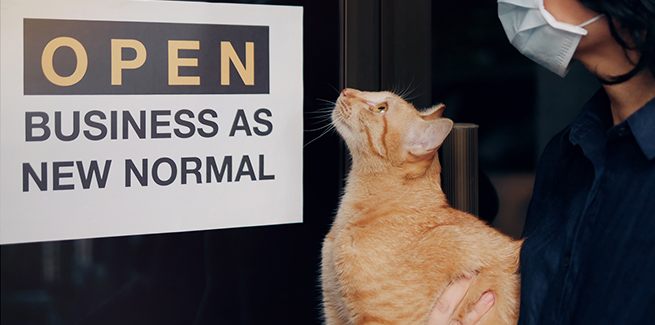When the going gets tough, veterinary teams get nimble

While musing on the incredible changes that have overtaken the veterinary profession in response to COVID-19, AAHA Senior Veterinary Officer Heather Loenser, DVM, observed, “We’re not a profession that does a good job at rapid change, but almost overnight we completely changed how we practice medicine.”
What’s clear is that the pandemic required veterinary hospitals to radically alter the way they’d been doing things—from the near-overnight transition to curbside service to the adoption of telemedicine in the wake of relaxed FDA oversight—and some have been pleasantly surprised not only at how well and quickly they adapted; they’ve also discovered some new ways of doing things that they plan to make standard operating procedures after the pandemic is over.
NEWStat talked to several practice owners and managers to find out what hidden (and not-so-hidden) strengths they discovered in themselves and their staff, what ways they’ve managed to adapt, and what they are doing differently that’s turned out to have lasting value.
Jennifer Galvin, practice manager at Advanced Animal Care in Fort Mojave, Arizona, said, “One thing that we were really struggling with was how to socially distance while performing euthanasias.” Galvin’s staff figured out a way to solve the problem of maintaining social distance while administering sedatives and euthanasia and still giving them room to grieve. “You add an IV-extension set, which allows the client to hold their pet while the veterinarian administers the drugs. We actually like this protocol so much that we will keep doing it even after the pandemic is over,” Galvin says. “It allows clients to be with their pet and have the process be as private as possible.”
Galvin says the strengths she observed in her team weren’t hidden at all: “They did exactly what I thought they’d do—they rose to the occasion. They worked through a scary time and continue to do so for the health and wellbeing of animals. They stuck it out when owners were lashing out because they were frightened and things were changing so quickly. My staff amazes me every single day. COVID didn’t change that.”
When Brian Bourquin, DVM, owner of Boston Veterinary Clinic in Boston, Massachusetts, and Brookline Veterinary Clinic in Brookline, Massachusetts, heard the word “nimble” used in the same sentence as “veterinarians” and “adapt to change,” he burst out laughing.
He considers himself to be the very definition of “non-nimble,” and tells a story to illustrate: “Someone suggested we start doing curbside and not allowing clients in the building [weeks before it became standard practice at most hospitals],” he recalled. “I said, ‘What? We can’t make clients wait outside! They’ll never stand for it!’ Within 24 hours, we had a protocol in place with orange tape and marked-off [parking] spots, and rules and regulations up on the board. We didn’t miss a beat.”
Bourquin described how, in the same meeting, another staffer said they’d need to divide into teams. “I said, ‘We can’t divide everyone up into teams! How will that work?’”
You can almost see him shrug as he says, “And then we did it.”
Bourquin noted that his urban practices are short on space, so they didn’t have room to social distance, which led to other adaptations: “We have a lot of millennial clients, so we had the option for telemedicine. We didn’t use it a lot, but it was there. And we already had an online store. So we were able to maneuver pretty quickly.”
Bourquin ramped up both services fast, and customers responded well.
But perhaps the biggest revelation, Bourquin says, is adjusting to the idea that maybe clients don’t have to come into the practice with their pets. “We’re seeing that pets are so much happier,” when brought straight from the curb to the exam room, sans owners. “They’re not hanging out in the waiting room with other animals they don’t know or don’t like,” he says. “And with mom and dad staying outside, the pets aren’t picking up on their anxiety. I think it’s opened our eyes that, just because it’s always been done that way, that doesn’t mean it’s the right way,” he says. “There can be other ways or better ways.”
He says he’ll likely keep offering curbside as an option once things return to normal and give clients the opportunity to go run errands or do other chores while staff looks after the pet inside.
And social distancing has made staff more conscientious about washing their hands between appointments and after eating. Bourquin says everyone in the hospital is just generally more germ conscious now.
And that awareness is unlikely to change, even after things go back to “normal.”
To read Part 2 of how veterinary professionals are coping and strengthening their practices, stay tuned to NEWStat!
Photo credit: © iStock/Chansom Pantip



